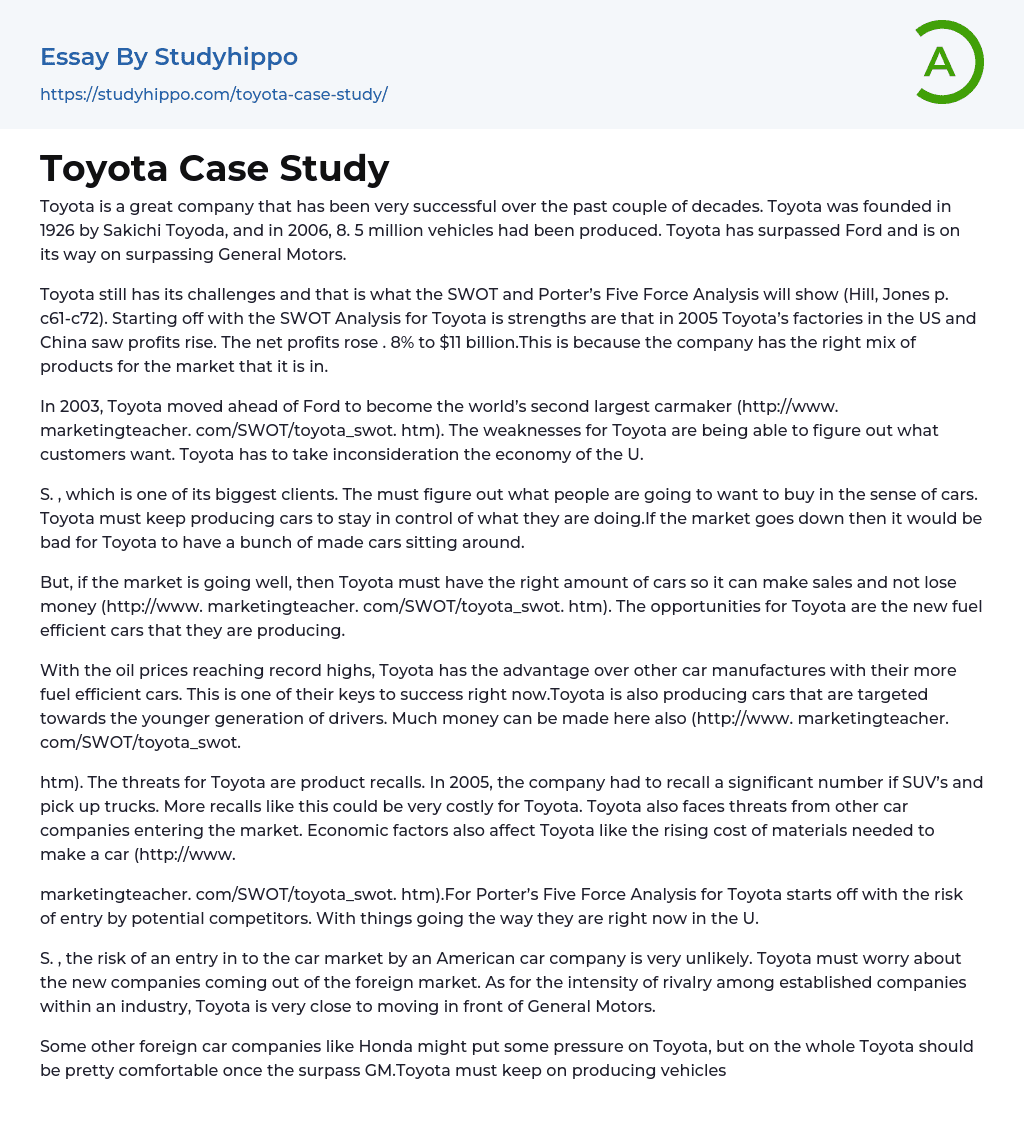Founded in 1926 by Sakichi Toyoda, Toyota has been highly successful in the past few decades, producing over 8.5 million vehicles by 2006 and surpassing Ford while gradually moving towards surpassing General Motors.
As per Hill and Jones (p. c61-c72), Toyota encounters obstacles that can be uncovered via SWOT and Porter's Five Force Analysis. The SWOT analysis detects strengths, including a boost in profits during 2005 whereby Toyota's US and China factories saw an upsurge of .8% to $11 billion because of the company's fitting product mix for its market.
As per information from http://www.marketingteacher.com/SWOT/toyota_swot.htm, Toyota overtook Ford in 2003 to become the second largest car manufacturer globally. Despite this achievement, Toyota's weaknesses include challenges in identifying customer preferences and adjusting to economic conditions in the United States.
As one of S.'s major clients, Toyota must anticipate car demand and
...maintain production to ensure operational control. Nevertheless, in the event of a market downturn, an excess of unsold cars could negatively impact Toyota's business.
Toyota needs to have a suitable number of cars to make profitable sales and avoid losses if the market is thriving (http://www.marketingteacher.com/SWOT/toyota_swot.htm). The new fuel efficient cars they are manufacturing generate possibilities for Toyota.
Amidst the unprecedented hike in oil prices, Toyota is currently enjoying an edge over its competitors through their production of automobiles that are more fuel-efficient. This factor is considered one of the key drivers of Toyota's success at present. Furthermore, Toyota is specifically tailoring their cars towards the younger drivers segment, thereby opening the doors for potential revenue growth (http://www.marketingteacher.com/SWOT/toyota_swot).
According to the source (http://www.htm), Toyota's potential risks include product recalls - exemplified by the significant recall of SUVs and
pickup trucks in 2005, which can be very expensive for the company. Additionally, Toyota faces competition from other car manufacturers entering the market, while economic factors are also a concern, such as the increasing costs of necessary materials to manufacture cars.
The website marketingteacher.com/SWOT/toyota_swot.htm provides a discussion of Porter's Five Force Analysis for Toyota. The analysis begins by considering the potential risk of new competitors entering the market, particularly given current conditions.
According to S., the possibility of an American car company entering the car market is highly unlikely. Instead, Toyota should be concerned about competition from emerging foreign companies. In terms of competition among established companies in the industry, Toyota is likely to surpass General Motors soon.
Although Honda and other foreign car companies can compete with Toyota, Toyota is expected to be at ease once they surpass GM. In order to succeed, Toyota needs to continue producing cars that meet customer demand and preferences. Failure to do so would hinder their progress towards their goals. Additionally, as supplies become increasingly expensive, Toyota's bargaining power with suppliers becomes crucial for their survival.
Toyota must make a profit to buy materials and keep vehicle production going. Without funds, they cannot obtain supplies which will hinder production. Given the expensive price of oil and the increasing number of companies developing electric cars, Toyota could consider making electric vehicles as an alternative to their current products.
Toyota potentially faces multiple threats, including the possibility of reduced car sales if consumers choose to walk or bike instead. Additionally, public transportation options like buses present a challenge for Toyota. However, an analysis of Toyota's financial ratios indicates that the company is currently in a
strong position. The Debt/Equity Ratio, Current Ratio, and Quick Ratio are all equal to or higher than industry averages.
Praising Toyota's financial intelligence, it is evident that the company invests and utilizes their resources effectively. Reviewing their profile on http://www.hoovers.com/toyota/--ID__41889,period__A--/free-co-fin-income.xhtml, it is impressive to see their strategic approach. In conclusion, Toyota deserves high commendation.
Toyota has steadily increased in success since its beginning, making it a strong competitor in the American car market due to their innovative technology and superior vehicle design. Their vehicles are known for quality, longevity, and exceptional fuel efficiency. Toyota is currently the top choice among consumers and few have been able to replicate their winning formula. It appears that Toyota will continue to dominate the industry in the near future.
Hill and Jones' book Strategic Management (2007) is cited on pages C61 to C72 and can be found at http://www.
The links to both "marketingteacher.com/SWOT/toyota_swot.htm" and "hoovers.com/toyota/--ID__41889,period__A--/free-co-fin-income.xhtml" are provided within HTML paragraph tags.
- Renault essays
- Truck essays
- chrysler essays
- The city essays
- Racing essays
- Bicycle essays
- Cars essays
- Rms Titanic essays
- Adidas essays
- Amazon essays
- Apple essays
- Bmw essays
- British Airways essays
- Burger King essays
- Coca-Cola essays
- Company essays
- Costco essays
- Dell essays
- Ebay essays
- Enron essays
- Facebook essays
- Ford Motor Company essays
- Gap essays
- General Motors essays
- Google essays
- Honda essays
- Ibm essays
- Ikea essays
- Intel essays
- Iphone essays
- Johnson and Johnson essays
- Kellogg essays
- Key essays
- Kfc essays
- Mcdonald's essays
- Microsoft essays
- Myspace essays
- Nestle essays
- Netflix essays
- Nike essays
- Nokia essays
- Pepsi essays
- Pepsico essays
- Red Bull essays
- Ryanair essays
- Samsung essays
- Sony essays
- Southwest Airlines essays
- Starbucks essays
- Supermarket essays




